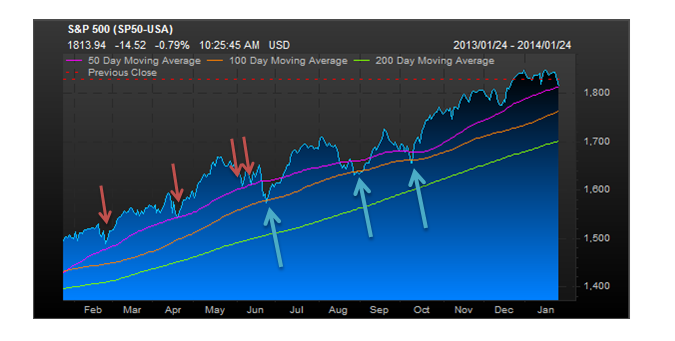 This post originally appeared about a year ago, in response to turbulence in emerging markets and a corresponding decline in U.S. markets.
This post originally appeared about a year ago, in response to turbulence in emerging markets and a corresponding decline in U.S. markets.
Portfolio managers have several standby risk-reduction strategies they rely on—diversified asset allocation, regular rebalancing, and the occasional market timing tactic—to guard against large drawdowns. But do they really work? What are the potential advantages and disadvantages of these strategies?
Asset allocation and rebalancing
Looking at asset allocation and rebalancing first, let’s assume you started 2013 with a $100,000 portfolio, with an allocation of 60-percent stocks/40-percent bonds. At the end of the year, that would have turned into $79,434 for stocks and $39,188 for bonds, using the S&P 500 and the Barclays Aggregate Bond indices, respectively, for a total of $118,622. Rebalancing would have brought this to $71,173 in stocks and $47,449 in bonds.
By reallocating more than 10 percent of your stock position to bonds, you would have been less exposed to the decline in stocks in January 2014 and more exposed to the gains in bonds. Although you would have been in a relatively superior position to someone who had just let the gains run without rebalancing, you still would have had a relatively large exposure to losses in the equity portion of your portfolio.
Moving average signals
If you elected to add another layer of risk protection, such as getting out if the market dropped below a moving average, your results would depend on the level of risk you wanted to eliminate—that is, the term for the moving average you selected. Using a 50-day moving average, for example, you might have gotten out at about 1,810 and been spared any decline after that point. If you were using a 100- or 200-day moving average, on the other hand, you would still have been in the market and exposed to any further losses down to that point.
On the flip side, using the 50-day moving average often results in many more moves in and out, with consequent costs and tax implications—and you potentially miss out on upside moves until the moving average catches up with the index. This is why tactical strategies tend to underperform in bull markets, as they miss upside by stepping out during what turn out to be temporary dips.
Looking at the chart below, for example, you can see that stepping out at either the 50- or 100-day moving average line anytime from January 2013 to January 2014 would have caused several sets of transaction costs, tax implications, and potential losses of upside, as the market continued to rise. Using these lengths as the basis of a tactical strategy would have been a loser during the period shown.

Selecting a risk-reduction metric, whether a moving average or another tool, is therefore a balance between the risk you’re willing to take and the number of transactions or amount of activity you’re willing to accept. The longer-term the metric, the more effective downside risk you’ll face, but the fewer transactions and costs.
Another consideration is how often you end up reviewing the portfolio. More frequent reviews aren’t necessarily better. Often, as the chart above shows, any breaks are just noise that would be ignored if you reviewed a portfolio monthly, but you would likely end up trading if reviewing daily or weekly.
Recasting the balance between risk and return
Putting all of this into context, what this means, ideally, is that you’ve already reviewed the data; decided on the approach you want to take, whether buy-and-hold or tactical; and laid out your decision rules. Looking at our hypothetical scenario, if you decided on a tactical rule based on the 50-day moving average, you probably would already be out—and just as important, you’d know when to get back in. For a longer-term indicator, you would still be in, but you’d know when you should get out. By properly testing these rules, you can remove a lot of the uncertainty from the portfolio management process and have a reasonable idea, based on history, of the risk levels you’re assuming—and the costs you'll incur.
You have to remember, though, that any set of rules is fallible. For example, had the flash crash stuck, it would have hit any tactical portfolio just as hard as a buy-and-hold one because it happened too fast. Markets could behave differently in the future, repeatedly nudging above your metric only to retreat and drop some more.
And, of course, as we see from the chart above, the market can turn around and take off again—potentially for years at a time. It certainly has done so throughout much of 2014. This is why market timing fell out of favor in the first place, because of persistent underperformance to buy-and-hold strategies during a multidecade U.S. bull market.
The idea behind any of these strategies is to recast the balance between risk and return, focusing more on risk—especially in higher-risk times, such as when valuations are high, like now—at the expense of some limited amount of return. I’m not actually recommending such strategies, as their applicability depends on the individual investor’s understanding and personal risk and return preferences, but I do think they’re worth a look.
The preceding contains hypothetical examples and is for illustrative purposes only. No specific investments were used in these examples. Actual results will vary. Asset allocation programs do not assure a profit or protect against loss in declining markets. No program can guarantee that any objective or goal will be achieved. All indices are unmanaged and investors cannot actually invest directly into an index. Unlike investments, indices do not incur management fees, charges, or expenses. Past performance does not guarantee future results.


 Print
Print



